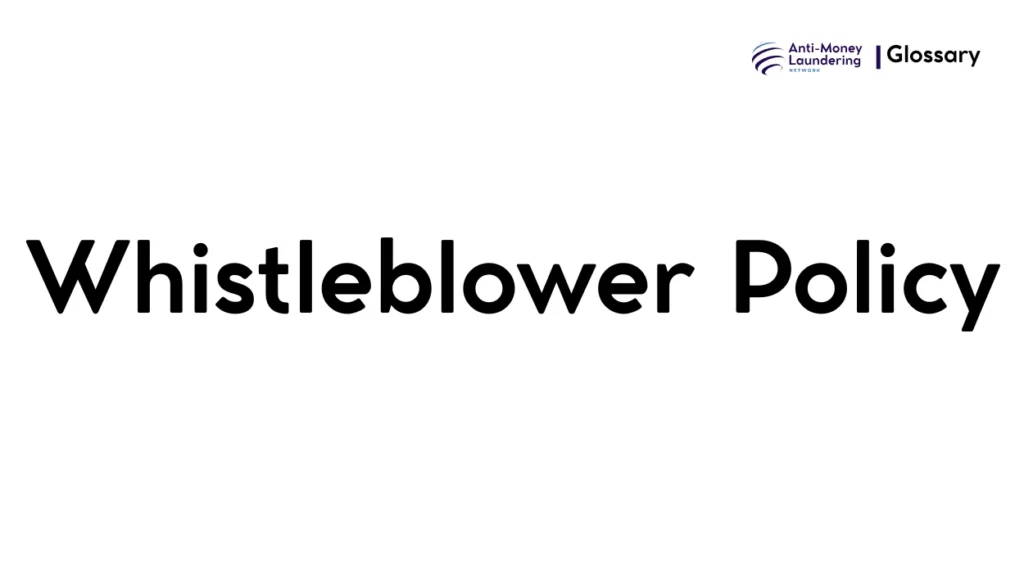Definition
A Whistleblower Policy in Anti-Money Laundering (AML) is a formal, institutional framework that encourages and protects employees and other stakeholders when reporting suspected money laundering activities or breaches of AML regulations within an organization. It establishes clear channels and safeguards for confidential disclosures to promote transparency and prompt corrective action.
Purpose and Regulatory Basis
The primary purpose of a whistleblower policy in AML is to detect, prevent, and mitigate money laundering risks by empowering insiders to report suspicious behaviors without fear of retaliation. These policies help financial institutions meet regulatory expectations and uphold ethical standards.
Globally, key regulatory frameworks mandate or strongly encourage whistleblower protections as part of AML compliance, including:
- FATF Recommendations: The Financial Action Task Force emphasizes the importance of promoting reporting of suspicious transactions and protecting whistleblowers to enhance AML effectiveness.
- USA PATRIOT Act (US): Includes provisions encouraging information sharing and whistleblower protections related to AML violations.
- EU AML Directives (AMLD): Require member states to establish frameworks permitting reporting of AML breaches, safeguarding whistleblowers from adverse consequences.
Complying with these regulations is crucial for financial institutions to avoid penalties and maintain operational integrity.
When and How it Applies
Whistleblower policies are operational whenever an individual within or connected to a financial institution suspects money laundering or terrorist financing activities. Typical triggers include:
- Observing unusual transaction patterns inconsistent with customer profiles.
- Detecting violations of AML controls or suspicious conduct within the organization.
- Identifying non-compliance with regulatory obligations by employees or third parties.
Such policies provide confidential, safe avenues for reporting, enabling timely investigations and remediation.
Types or Variants
Whistleblower policies in AML can take different forms or focus areas:
- Internal Reporting Channels: Reporting mechanisms within the institution, often via compliance officers or dedicated hotlines.
- External Reporting Options: Where whistleblowers can report directly to regulators or law enforcement if internal processes fail or pose a conflict.
- Anonymous vs. Named Reports: Policies may allow anonymous reporting or require identification to protect against abuse but encourage accountability.
Institutions may combine these elements to tailor effective whistleblower frameworks.
Procedures and Implementation
Implementing an effective whistleblower policy involves several key steps:
- Policy Development: Craft clear, accessible policy documents detailing the purpose, scope, protections, and procedures.
- Communication and Training: Educate employees and stakeholders on how to recognize suspicious activities and how to report concerns safely.
- Establishment of Reporting Channels: Set up secure, confidential hotlines, email systems, or online portals managed by trained compliance personnel.
- Protection Measures: Ensure protection against retaliation, including legal safeguards and organizational support mechanisms.
- Investigation Protocols: Define clear processes for timely, thorough investigation of reported concerns.
- Record-Keeping and Monitoring: Maintain confidential logs of reports and outcomes for compliance audits and regulatory reviews.
Impact on Customers/Clients
From the customer’s perspective, whistleblower policies indirectly safeguard their interests by helping institutions identify illicit activities that could harm their assets or reputation. Customers are entitled to:
- Expect institutional accountability and compliance vigilance.
- Understand confidentiality protections surrounding their information if involved in any report.
Restrictions include maintaining client privacy and avoiding misuse of whistleblower channels for personal grievances unrelated to AML.
Duration, Review, and Resolution
Whistleblower reports are governed by:
- Duration: Reports should be acted upon promptly, with investigation timelines varying by complexity but typically within weeks to a few months.
- Review: Compliance teams regularly review policy effectiveness, investigation outcomes, and employee feedback.
- Resolution: Outcomes may include corrective actions, enhanced controls, or referral to law enforcement.
- Ongoing Obligations: Institutions must maintain support for whistleblowers post-reporting and update policies to reflect evolving risks or regulations.
Reporting and Compliance Duties
Institutions carry responsibilities such as:
- Implementing accessible, reliable whistleblower mechanisms.
- Documenting all reports and how they were addressed.
- Protecting whistleblowers from retaliation.
- Ensuring compliance with national laws concerning whistleblower rights.
- Reporting serious findings to regulators when required.
Failure to comply can result in regulatory sanctions, reputational damage, and operational setbacks.
Related AML Terms
Whistleblower Policy connects with other AML concepts including:
- Suspicious Activity Reports (SARs): Whistleblower disclosures often lead to filing SARs with authorities.
- Know Your Customer (KYC): Whistleblower tips may expose gaps in KYC procedures.
- Due Diligence and Monitoring: Reports may highlight inadequacies in ongoing transaction monitoring.
- Compliance Culture: Encouraging whistleblowing fosters a culture of compliance and integrity.
Challenges and Best Practices
Common challenges include:
- Fear of retaliation discouraging reporting.
- Lack of awareness among employees about reporting procedures.
- Handling anonymous reports while verifying credibility.
- Balancing transparency with confidentiality.
Best practices to overcome these issues are:
- Robust anti-retaliation policies actively enforced.
- Regular training and awareness programs.
- Multiple accessible, confidential reporting channels.
- Clear linkage between whistleblowing and AML risk management.
Recent Developments
Recent trends in whistleblower policies within AML include:
- Technological innovations such as encrypted digital platforms allowing anonymous, secure reporting.
- Enhanced regulatory focus worldwide on whistleblower protections as a key AML pillar.
- Integration with data analytics and AI to prioritize and investigate reports efficiently.
- Cross-border cooperation emphasizing whistleblower roles in multinational AML investigations.
A Whistleblower Policy in Anti-Money Laundering is essential for fostering transparency, compliance, and early detection of illicit financial activities. By establishing protected reporting channels, institutions not only comply with global regulations but also strengthen their defenses against money laundering risks. Implementing, maintaining, and continuously improving these policies is crucial for a robust AML framework in today’s complex financial environment.

